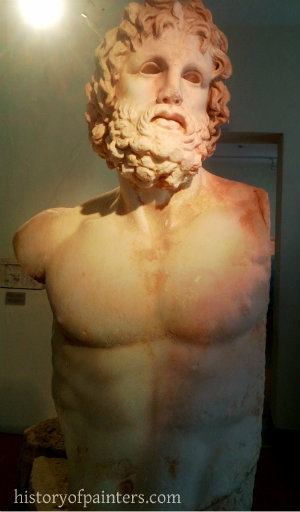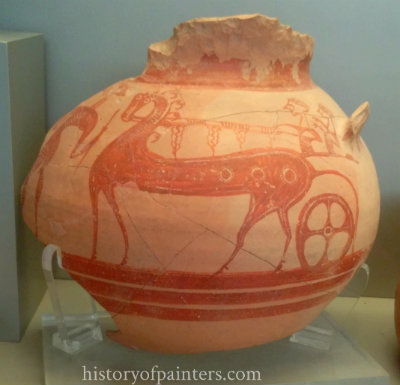Search:: Artists Alphabetically Artists by Country Artists by Century Artists by Movement
Classic Greek ArtAncient Greek Pottery
Ancient Greek Jewelry
Ancient Greek Sculpture
Ancient Greek Swords
Characteristics of Greek Art
In Greece, painting first ceased to be subordinate to
architecture,
and became independent. Greek painters used home made pigments,
individual to each artist. The recipes were guarded closely and handed
down generation to generation. Most home-made pigments were created
from bone, charcoal, ground stone, and naturally occurring earth
pigments.
According
to art historian, Walter Pater, "The supreme Hellenic culture is a
sharp edge of light across this gloom. The fiery, stupefying wine
becomes in a happier climate clear and exhilarating. The Dorian worship
of Apollo, rational, chastened, debonair, with his unbroken daylight,
always opposed to the sad Chthonian divinities, is the aspiring
element, by force and spring of which Greek religion sublimes itself.
Out of Greek religion, under happy conditions, arises Greek art, to
minister to human culture. It was the privilege of Greek religion to be
able to transform itself into an artistic ideal."
In early days,
there was skill in the ornamentation of vases and in mural painting.
Yet, with much spirit and feeling, there was a conventional treatment.
The earliest artist of whom we know much is Polygnotus, about 420 B.C.,
whose groups of profile figures were described as remarkable for their
life-like character and fine coloring. Apollodorus of Athens was
distinguished, but Zeuxis of Heraclea is said to have been the first to
paint movable pictures. He is famed for his marvelous power of
imitation: the birds pecked at a bunch of grapes which he painted. But
even he was outdone by Parrhasius. Zeuxis, however, had far higher
qualities than those of a literal copyist. The most successful of the
Greek painters was Apelles. Among his masterpieces was a painting of
Venus rising from the waves, and a portrait of Alexander the Great. We
have not in painting, as in sculpture, a store of monuments of Greek
art; but the skill of the Greeks in painting fell behind their
unequaled genius in molding the human form in bronze and marble.

Greek
historian, F. B. Tarbell explains "The art of painting was in as high
esteem in Greece as the art of sculpture and, if we may believe the
testimony of Greek and Roman writers, achieved results as important and
admirable. But the works of the great Greek painters have utterly
perished, and imagination, though guided by ancient descriptions and by
such painted designs as have come down to us, can restore them but
dimly and doubtfully. The subject may therefore here be dismissed with
comparative brevity."
To view larger images of Greek art click here
The Greeks more and more broke away in a free
and
joyous spirit from the stiff and conventional styles of Egyptian and
Oriental art. In the room of the somber, massive edifices of Egypt,
they combined symmetry and beauty with grandeur in the temples which
they erected. The temples were originally colored within and without.
Three styles were developed, the Doric, the Ionic, and the Corinthian.
In the Doric, the column and entablature have the most solid and simple
form. The column has no other base than the common platform on which
the pillars rest, and the capital that surmounts it is a plain slab.
Originality
is a distinguishing trait in Classic Greek Art. Whatever the Greeks
borrowed from others they made their own, and reproduced in a form
peculiar to themselves. They were never servile copyists. A spirit of
humanity, in the broad sense of the term, pervades their painting,
sculpture and mosaics. Their sense of form, including a perception of
beauty, of harmony and proportion--made them the leaders of Western
Civilization. -Richard Muther, The History of Painting, Henry and Co.,
London, 1896
Greek painting Techniques and Formula
Greek artists created their masterpieces using homemade pigments. Pigments were made according to ancient recipes. Artists used many different ingredients to achieve the desired colors, including burnt apple seeds, pulverized semiprecious stones such as lapis lazuli, charcoal, animal and human bones, naturally occurring earth pigments such celadonite and chlorite, pomegranate juice and ground up ibulio beetles. Each artist mixing up his own a batch to use as needed.
F. B. Tarbell declares"Two artists of the highest distinction now appear upon the scene. They are Zeuxis and Parrhasius. The rather vague remark of a Roman writer, that they both lived "about the time of the Peloponnesian War" (431-404 B.C.) is as definite a statement as can safely be made about their date. Parrhasius was born at Ephesus, Zeuxis at some one or other of the numerous cities named Heraclea. Both traveled freely from place to place, after the usual fashion of Greek artists, and both naturally made their home for a time in Athens. Zeuxis availed himself of the innovation of Apollodorus and probably carried it farther. Indeed, he is credited by one Roman writer with being the founder of the new method. The strength of Parrhasius is said to have lain in subtlety of line, which would suggest that with him, as with Polygnotus, painting was essentially outline drawing. Yet he too can hardly have remained unaffected by the new chiaroscuro."Egg
tempera is a radiant, semi-translucent paint that dries almost
immediately. The process of setting up the paint was time
consuming and technical. The artist used 1 egg, 1 tsp. raw olive
oil, a few drops if vinegar added to ground pigment. The process
to make just one color took about 30 minutes. Brushes were made from
squirrel hair, hogs bristle and cat whiskers. 
To view larger images of Greek art click here
Toxic pigments
Many of the pigments were extremely toxic causing the person mixing them to have oozing sores that never healed, patches of baldness, fingernails that fell off and in a few short years a painful ugly death. Old slaves were usually employed to grind up the pigments and mix up the binders.
After the Greeks
The Romans like the Greeks loved beauty and art. Upper income people had every wall of their home decorated with beautiful murals. Romans favored nature scenes with birds in flight, fish, dogs and exotic animals. Mythological scenes and philosophers in contemplation were also popular. Soc, According to noted historian, Hendrik van Loon "The Romans, like their Carthaginian rivals, were too busy administering other people and making money to have much love for “useless and unprofitable” adventures of the spirit. They conquered the world and built roads and bridges but they borrowed their art wholesale from the Greeks. They invented certain practical forms of architecture which answered the demands of their day and age. But their statues and their histories and their mosaics and their poems were mere Latin imitations of Greek originals. Without that vague and hard-to- define something which the world calls “personality,” there can be no art and the Roman world distrusted that particular sort of personality. The Empire needed efficient soldiers and tradesmen. The business of writing poetry or making pictures was left to foreigners."

☼☼☼☼☼☼☼☼☼☼
Require more facts and information
about ancient Greek Art and artifacts? Poke around every nook and
cranny of the known universe for information this subject. Search
Here
If
you feel you have worthwhile information you would like to contribute
we would love to hear from you. We collect essential biographical
information and artist quotes from folks all over the globe and
appreciate your participation. When submitting please, if possible,
site the source and provide English translation. Please
submit your comment to the editor, via e-mail and if possible site the
source. Thank you!
© HistoryofPainters.com
If you like this page and wish to share it, you
are welcome to link to it, with our thanks.
copyright 2017 - historyofpainters.com